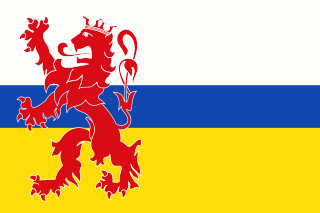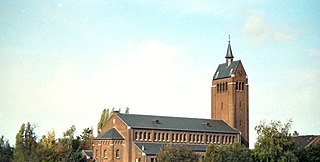| Noor | |
|---|---|
 Source of the river Noor at Wesch | |
 Map of South Limburg. The Noor valley is the lower dark green area below the M. | |
| Location | |
| Country | Netherlands, Belgium |
| Physical characteristics | |
| Source | |
| - location | Wesch, near Noorbeek |
| Mouth | |
- location | Voer near Voeren |
- coordinates | 50°45′49″N5°47′37″E / 50.76361°N 5.79361°E Coordinates: 50°45′49″N5°47′37″E / 50.76361°N 5.79361°E |
| Basin features | |
| Progression | Voer→ Meuse→ North Sea |
The Noor or Langwater (Limburgish: Laankwater) is a river in the Netherlands and Belgium. The Noor is a right-bank tributary to the river Voer, which later joins the Meuse. Rising in Eijsden-Margraten, in the Dutch province of Limburg, the Noor eventually drains in the river Voer in Voeren, in the Belgian province of Limburg.

The Netherlands, sometimes known as Holland, is a country located mainly in Northwestern Europe. The European portion of the Netherlands consists of twelve separate provinces that border Germany to the east, Belgium to the south, and the North Sea to the northwest, with maritime borders in the North Sea with Belgium, Germany and the United Kingdom. Together with three island territories in the Caribbean Sea—Bonaire, Sint Eustatius and Saba—it forms a constituent country of the Kingdom of the Netherlands. The official language is Dutch, but a secondary official language in the province of Friesland is West Frisian.

Belgium, officially the Kingdom of Belgium, is a country in Western Europe. It is bordered by the Netherlands to the north, Germany to the east, Luxembourg to the southeast, France to the southwest, and the North Sea to the northwest. It covers an area of 30,688 km2 (11,849 sq mi) and has a population of more than 11.4 million. The capital and largest city is Brussels; other major cities are Antwerp, Ghent, Charleroi and Liège.

A tributary or affluent is a stream or river that flows into a larger stream or main stem river or a lake. A tributary does not flow directly into a sea or ocean. Tributaries and the main stem river drain the surrounding drainage basin of its surface water and groundwater, leading the water out into an ocean.
Contents
A source of the Noor can be found at the Brigida spring (Dutch: Sint Brigidabron) in the hamlet of Wesch, north of the village of Noorbeek, in the municipality of Eijsden-Margraten, where water wells up from the chalk underground. [1] The spring and the adjacent 18th century lavoir, named after Brigid of Kildare, patron saint of the village of Noorbeek, form a Dutch national heritage site. [1] [2] From Wesch the river flows south, passing west of the village of Noorbeek (Dutch: Noor river), which was named after the river. Passing Noorbeek the Noor continues southward through the Noor valley, south of the plateau of Margraten, and is one of only few Dutch rivers to flow southward into Belgium. The Dutch part of the Noor valley (Dutch: Noordal) contains a nature reserve, with the same name, managed by the Dutch Society for preservation of Nature Monuments. [3]

Saint Brigid of Kildare or Brigid of Ireland is one of Ireland's patron saints, along with Patrick and Columba. Irish hagiography makes her an early Irish Christian nun, abbess, and foundress of several monasteries of nuns, including that of Kildare in Ireland, which was famous and was revered. Her feast day is 1 February, which was originally a pagan festival called Imbolc, marking the beginning of spring. Her feast day is shared by Dar Lugdach, who tradition says was her student, close companion, and the woman who succeeded her.

A spring is a point at which water flows from an aquifer to the Earth's surface. It is a component of the hydrosphere.

Dutch(
After crossing the border into Belgium the Noor flows past Castle Altenbroek and the Watermill at Altenbroek in Voeren. This 18th century castle is a Flemish heritage site. [4] The Belgian part of the Noor valley is a Flemish protected landscape as part of the larger Voer valley protected landscape. [5] The Noor eventually drains in the river Voer near the village of 's-Gravenvoeren in the municipality of Voeren.

Voeren is a Flemish municipality located in the Belgian province of Limburg. Bordering the Netherlands to the north and the Walloon province of Liège to the south, it is geographically detached from the rest of Flanders, making Voeren an exclave of Flanders. Voeren's name is derived from that of a small right-bank tributary of the Meuse, the Voer, which flows through the municipality.

Flanders is the Dutch-speaking northern portion of Belgium and one of the communities, regions and language areas of Belgium. However, there are several overlapping definitions, including ones related to culture, language, politics and history, and sometimes involving neighbouring countries. The demonym associated with Flanders is Fleming, while the corresponding adjective is Flemish. The official capital of Flanders is Brussels, although the Brussels Capital Region has an independent regional government, and the government of Flanders only oversees the community aspects of Flanders life in Brussels such as (Flemish) culture and education.

Heritage registers in Belgium include immovable heritage such as World Heritage Sites, and National heritage sites, but also intangible cultural heritage. The agency responsible for keeping and updating inventories of immovable heritage is dependent on the region, as is the name for the object, which is called Beschermd erfgoed, Biens classés or Kulturdenkmal depending on the language of the municipality of the location.




















